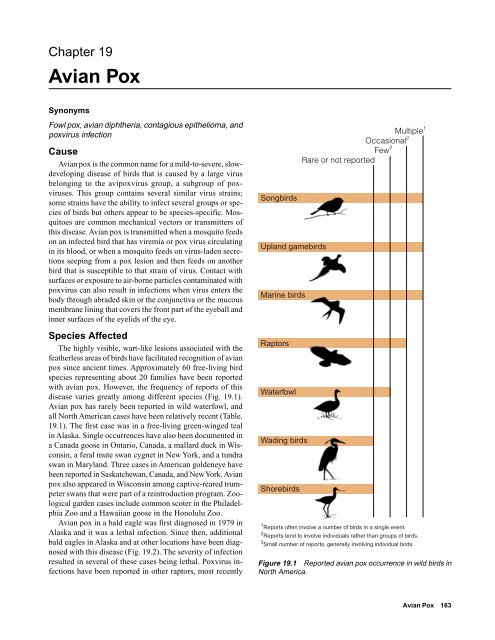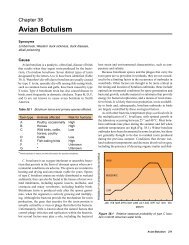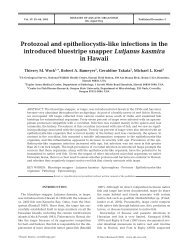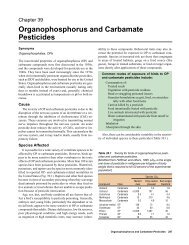Chapter 19 Avian Pox - National Wildlife Health Center
Chapter 19 Avian Pox - National Wildlife Health Center
Chapter 19 Avian Pox - National Wildlife Health Center
You also want an ePaper? Increase the reach of your titles
YUMPU automatically turns print PDFs into web optimized ePapers that Google loves.
<strong>Chapter</strong> <strong>19</strong><br />
<strong>Avian</strong> <strong>Pox</strong><br />
Synonyms<br />
Fowl pox, avian diphtheria, contagious epithelioma, and<br />
poxvirus infection<br />
Cause<br />
<strong>Avian</strong> pox is the common name for a mild-to-severe, slowdeveloping<br />
disease of birds that is caused by a large virus<br />
belonging to the avipoxvirus group, a subgroup of poxviruses.<br />
This group contains several similar virus strains;<br />
some strains have the ability to infect several groups or species<br />
of birds but others appear to be species-specific. Mosquitoes<br />
are common mechanical vectors or transmitters of<br />
this disease. <strong>Avian</strong> pox is transmitted when a mosquito feeds<br />
on an infected bird that has viremia or pox virus circulating<br />
in its blood, or when a mosquito feeds on virus-laden secretions<br />
seeping from a pox lesion and then feeds on another<br />
bird that is susceptible to that strain of virus. Contact with<br />
surfaces or exposure to air-borne particles contaminated with<br />
poxvirus can also result in infections when virus enters the<br />
body through abraded skin or the conjunctiva or the mucous<br />
membrane lining that covers the front part of the eyeball and<br />
inner surfaces of the eyelids of the eye.<br />
Species Affected<br />
The highly visible, wart-like lesions associated with the<br />
featherless areas of birds have facilitated recognition of avian<br />
pox since ancient times. Approximately 60 free-living bird<br />
species representing about 20 families have been reported<br />
with avian pox. However, the frequency of reports of this<br />
disease varies greatly among different species (Fig. <strong>19</strong>.1).<br />
<strong>Avian</strong> pox has rarely been reported in wild waterfowl, and<br />
all North American cases have been relatively recent (Table.<br />
<strong>19</strong>.1). The first case was in a free-living green-winged teal<br />
in Alaska. Single occurrences have also been documented in<br />
a Canada goose in Ontario, Canada, a mallard duck in Wisconsin,<br />
a feral mute swan cygnet in New York, and a tundra<br />
swan in Maryland. Three cases in American goldeneye have<br />
been reported in Saskatchewan, Canada, and New York. <strong>Avian</strong><br />
pox also appeared in Wisconsin among captive-reared trumpeter<br />
swans that were part of a reintroduction program. Zoological<br />
garden cases include common scoter in the Philadelphia<br />
Zoo and a Hawaiian goose in the Honolulu Zoo.<br />
<strong>Avian</strong> pox in a bald eagle was first diagnosed in <strong>19</strong>79 in<br />
Alaska and it was a lethal infection. Since then, additional<br />
bald eagles in Alaska and at other locations have been diagnosed<br />
with this disease (Fig. <strong>19</strong>.2). The severity of infection<br />
resulted in several of these cases being lethal. <strong>Pox</strong>virus infections<br />
have been reported in other raptors, most recently<br />
Songbirds<br />
Upland gamebirds<br />
Marine birds<br />
Raptors<br />
Waterfowl<br />
Wading birds<br />
Shorebirds<br />
Multiple 1<br />
Occasional 2<br />
Few 3<br />
Rare or not reported<br />
1 Reports often involve a number of birds in a single event.<br />
2 Reports tend to involve individuals rather than groups of birds.<br />
3 Small number of reports, generally involving individual birds.<br />
Figure <strong>19</strong>.1 Reported avian pox occurrence in wild birds in<br />
North America.<br />
<strong>Avian</strong> <strong>Pox</strong> 163
Table <strong>19</strong>.1<br />
avian pox.<br />
9<br />
Waterfowl in North America reported to have<br />
Year of first<br />
report<br />
Species Locations in species<br />
Harlequin duck Alaska <strong>19</strong>94<br />
Blue-winged teal Wisconsin <strong>19</strong>91<br />
Wood duck Wisconsin <strong>19</strong>91<br />
Redhead duck Wisconsin <strong>19</strong>91<br />
Trumpeter swan Wisconsin <strong>19</strong>89<br />
Common goldeneye New York <strong>19</strong>94<br />
Saskatchewan <strong>19</strong>81<br />
Tundra swan Maryland <strong>19</strong>78<br />
Green-winged teal Alaska <strong>19</strong>78<br />
Mallard Wisconsin <strong>19</strong>78<br />
Canada goose Ontario <strong>19</strong>75<br />
Common scoter Pennsylvania <strong>19</strong>67<br />
Mute swan New York <strong>19</strong>64<br />
1<br />
4<br />
2<br />
1<br />
1<br />
1<br />
2<br />
2<br />
2<br />
8<br />
1<br />
1<br />
2<br />
1 1<br />
1<br />
Figure <strong>19</strong>.2 Number of bald eagles with cutaneous pox by<br />
State, <strong>19</strong>79–97. (From <strong>National</strong> <strong>Wildlife</strong> <strong>Health</strong> <strong>Center</strong> records.)<br />
in the eastern screech owl and barred owl in Florida (Table<br />
<strong>19</strong>.2).<br />
On Midway Atoll, large numbers of colonial nesting birds,<br />
such as the Laysan albatross, have become infected with avian<br />
pox. Red-tailed tropicbirds on Midway Atoll previously had<br />
been affected by avian pox. The shift in predominant species<br />
infected relates to the dramatic shift in population densities<br />
for the two species over time (<strong>19</strong>63–<strong>19</strong>78). Mourning dove,<br />
finches, and other perching birds using backyard feeders<br />
2<br />
(Fig. <strong>19</strong>.3) frequently have been reported to have been struck<br />
by avian pox epizootics. <strong>Avian</strong> pox is suspected as a factor<br />
in the decline of forest bird populations in Hawaii and northern<br />
bobwhite quail in the southeastern United States, where<br />
it is also an important disease of wild turkey.<br />
Distribution<br />
<strong>Avian</strong> pox occurs worldwide, but little is known about its<br />
prevalence in wild bird populations. The increased frequency<br />
of reported cases of this highly visible disease and the involvement<br />
of new bird species during recent years suggests<br />
that avian pox is an emerging viral disease. Birds can become<br />
disease carriers and spread avian pox among local populations,<br />
such as between birdfeeding stations, and along migratory<br />
routes used by various bird species. Mosquitoes that<br />
feed on birds play the most important role for both disease<br />
transmission and long term disease maintenance. However,<br />
contamination of perches and other surfaces used by captive<br />
birds can perpetuate disease in captivity. <strong>Pox</strong> outbreaks are<br />
commonly reported at aviaries, rehabilitation centers, and<br />
other places where confinement provides close contact among<br />
birds. The disease can spread rapidly when avian pox is introduced<br />
into such facilities. Species that would not ordinarily<br />
have contact with avian pox virus in the wild often<br />
become infected in captivity if the strain of virus present is<br />
capable of infecting a broad spectrum of species. Common<br />
murres rescued from an oil spill in California developed poxvirus<br />
lesions while they were in a rehabilitation center. Endangered<br />
avian species also have been infected during captive<br />
rearing.<br />
Seasonality<br />
Although wild birds can be infected by pox virus yearround<br />
(Fig. <strong>19</strong>.4), disease outbreaks have been associated<br />
with the environmental conditions, the emergence of vector<br />
populations, and the habits of the species affected. Environmental<br />
factors such as temperature, humidity, moisture, and<br />
protective cover all play a role in the occurrence of this disease<br />
by affecting virus survival outside of the bird host. <strong>Avian</strong><br />
pox virus can withstand considerable dryness, thereby remaining<br />
infectious on surfaces or dust particles. Mosquitoes<br />
that feed on birds are the most consistent and efficient transmitters<br />
of this disease. Mosquito populations are controlled<br />
by breeding habitat and annual moisture.<br />
The time of appearance and magnitude of vector populations<br />
varies from year to year, depending on annual weather<br />
conditions. This influences the appearance and severity of<br />
the disease in any given year. Only limited studies have been<br />
carried out to assess the relations between avian pox and<br />
insect vector populations. Studies on the Island of Hawaii<br />
disclose a close relation between the prevalence of poxvirus<br />
infections in forest birds and seasonal mosquito cycles. The<br />
lowest prevalence of pox virus infection in California quail<br />
in Oregon was reported in the dry summer months and the<br />
164 Field Manual of <strong>Wildlife</strong> Diseases: Birds
highest was reported during the wetter fall and winter months.<br />
In Florida, reports of avian pox in wild turkey correspond to<br />
the late summer and early fall mosquito season. On Sand<br />
Island of the Midway Atoll, avian pox was first reported in<br />
September l963 in the nestlings of the red-tailed tropicbird.<br />
In March and April of the late l970s, this disease was found<br />
in nestling Laysan albatross on Sand Island. This is an example<br />
of disease seasonality influenced by dramatic shifts<br />
in predominant species populations.<br />
Birdfeeding stations have been the source of numerous<br />
poxvirus outbreaks in the continental United States<br />
(Fig. <strong>19</strong>.3). Contact transmission of the virus through infected<br />
surfaces and close association of birds using those feeders is<br />
the likely means of transmission during cooler periods of<br />
the year when mosquitoes are not a factor, and birdfeeders<br />
provide additional sources of infection when mosquitoes are<br />
present.<br />
Field Signs<br />
Birds with wart-like nodules on one or more of the featherless<br />
areas of the body, including the feet, legs, base of the<br />
beak, and eye margin should be considered suspect cases of<br />
avian pox (Fig. <strong>19</strong>.5). The birds may appear weak and emaciated<br />
if the lesions are extensive enough to interfere with<br />
their feeding. Some birds may show signs of labored breathing<br />
if their air passages are partially blocked. Although the<br />
course of this disease can be prolonged, birds with extensive<br />
lesions are known to completely recover if they are able to<br />
feed.<br />
Gross Lesions<br />
<strong>Avian</strong> pox has two disease forms. The most common form<br />
is cutaneous and it consists of warty nodules that develop on<br />
the featherless parts of the bird. This form of the disease is<br />
usually self-limiting; the lesions regress and leave minor<br />
scars. However, these nodules can become enlarged and clustered,<br />
thus causing sight and breathing impairment and feeding<br />
difficulty (Figs. <strong>19</strong>.6A and B). Secondary bacterial and<br />
other infections are common with this form of the disease,<br />
and these infections can contribute to bird mortality. In some<br />
birds, feeding habits result in the large warty nodules becoming<br />
abraded and then infected by bacterial and fungal<br />
infections (Figs. <strong>19</strong>.6C and D).<br />
The internal form of disease is referred to as wet pox and<br />
it is primarily a problem of young chickens and turkeys. This<br />
diphtheritic form appears as moist, necrotic lesions on the<br />
mucus membranes of the mouth and upper digestive and respiratory<br />
tracts (Fig. <strong>19</strong>.7), and it has occasionally been reported<br />
in wild birds (Fig. <strong>19</strong>.8). This form of avian pox probably<br />
occurs more frequently in wild birds than it is reported<br />
because it is less observable than the cutaneous form. Also,<br />
the more severe consequences of wet pox undoubtedly causes<br />
greater morbidity and mortality, thereby leading to removal<br />
of infected birds by predators and scavengers.<br />
Table <strong>19</strong>.2 Birds of prey from North America reported to<br />
have contracted avian pox.<br />
Year of first<br />
report<br />
Species Locations in species<br />
Barred owl Florida <strong>19</strong>95<br />
Bald eagle Maine <strong>19</strong>95<br />
Ohio <strong>19</strong>95<br />
Rhode Island <strong>19</strong>93<br />
Michigan <strong>19</strong>92<br />
Minnesota <strong>19</strong>89<br />
California <strong>19</strong>87<br />
Nebraska <strong>19</strong>87<br />
Maryland <strong>19</strong>86<br />
Massachusetts <strong>19</strong>86<br />
South Dakota <strong>19</strong>86<br />
Wisconsin <strong>19</strong>86<br />
Pennsylvania <strong>19</strong>85<br />
Arkansas <strong>19</strong>84<br />
New York <strong>19</strong>83<br />
Florida <strong>19</strong>82<br />
Virginia <strong>19</strong>81<br />
Washington <strong>19</strong>81<br />
Alaska <strong>19</strong>78<br />
Eastern screech owl Florida <strong>19</strong>94<br />
Peregrine falcon New York <strong>19</strong>94<br />
Ferruginous hawk Texas <strong>19</strong>93<br />
Golden eagle Missouri <strong>19</strong>89<br />
Kansas <strong>19</strong>86<br />
California <strong>19</strong>76<br />
British Columbia <strong>19</strong>70<br />
Red-tailed hawk Nebraska <strong>19</strong>88<br />
Wisconsin <strong>19</strong>85<br />
Washington <strong>19</strong>81<br />
Missouri <strong>19</strong>70<br />
Rough-legged hawk North Dakota <strong>19</strong>71<br />
Diagnosis<br />
A presumptive diagnosis of avian pox can be made from<br />
the gross appearance of the wart-like growths that appear on<br />
body surfaces. However, these observations must be confirmed<br />
by examining lesions microscopically for character-<br />
<strong>Avian</strong> <strong>Pox</strong> 165
4<br />
2<br />
2<br />
1<br />
3<br />
1 3<br />
2<br />
4<br />
1<br />
1<br />
5<br />
6<br />
4<br />
Figure <strong>19</strong>.3 Number of avian pox outbreaks involving passerines at<br />
birdfeeding stations by State, <strong>19</strong>75–79. (<strong>National</strong> <strong>Wildlife</strong> <strong>Health</strong> <strong>Center</strong><br />
Database.)<br />
Figure <strong>19</strong>.4<br />
Seasonal avian pox outbreaks in wild birds.<br />
166 Field Manual of <strong>Wildlife</strong> Diseases: Birds
Figure <strong>19</strong>.5 (A) <strong>Avian</strong> pox lesions typically<br />
are found on featherless parts of<br />
the body. This Laysan albatross chick<br />
has small pox nodules on the face and<br />
eyelid. (B) As the disease progresses,<br />
these lesions become more extensive.<br />
(C) Lesions also are commonly seen on<br />
the legs and (D) feet.<br />
A<br />
Photo by Wallace Hansen<br />
B<br />
Photo by Milton Friend<br />
C<br />
Photo by Milton Friend<br />
D<br />
Photo by Wallace Hansen<br />
<strong>Avian</strong> <strong>Pox</strong> 167
B<br />
A<br />
Photos by James Runningen<br />
C<br />
Figure <strong>19</strong>.6 <strong>Pox</strong> lesions can be so extensive that they impair<br />
breathing, sight, and feeding as seen in these bald eagles:<br />
(A) extensive infection of both sides of the face, (B) obstruction<br />
to feeding due to the size and location of these lesions at<br />
the base of the bill, and (C) obstruction of sight due to complete<br />
occlusion of the eye. (D) Massive facial lesions often<br />
become abraded and subject to secondary infections.<br />
D<br />
➡<br />
Figure <strong>19</strong>.7 Diphtheritic form of avian pox (arrow) in a Laysan<br />
albatross at Midway Atoll.<br />
Photo by Lou Sileo<br />
168 Field Manual of <strong>Wildlife</strong> Diseases: Birds
Species group<br />
Marine birds<br />
Species<br />
White-tailed tropicbird<br />
Laysan albatross<br />
Common murre<br />
Upland gamebirds<br />
Morning dove<br />
Ruffed grouse<br />
Northern bobwhite quail<br />
Songbirds<br />
Bullfinch<br />
House finch<br />
Figure <strong>19</strong>.8<br />
reported.<br />
Wild bird species in which wet pox has been<br />
istic cellular inclusion bodies. <strong>Avian</strong> pox is confirmed by<br />
virus isolation and serological identification. Submit the<br />
whole bird or the affected body part (for example, the feet or<br />
head) to a disease diagnostic laboratory that has virus isolation<br />
capabilities. Immediately freeze samples that must be<br />
held for more than 24 hours before shipment. Virus isolation<br />
can be attempted from a live bird by collecting samples from<br />
the affected area. However, consult with the diagnostic laboratory<br />
staff before collecting samples.<br />
Control<br />
The fundamental principle for controlling avian pox is to<br />
interrupt virus transmission. The difficulty in applying control<br />
procedures is related to the type of transmission taking<br />
place, the mobility of the infected birds, and the size of the<br />
affected area. The more confined a population at risk, the<br />
more effective the control procedures will be. Therefore, prevention<br />
is the first method for controlling this disease. Vector<br />
control (primarily mosquitoes) in and around the disease<br />
area should be considered first. Identifying and eliminating<br />
vector breeding and resting sites together with controlling<br />
adult mosquito populations are most desirable. Removing<br />
heavily infected animals is also helpful because it diminishes<br />
the source of virus for vector populations. This also<br />
reduces the opportunity for contact transmission between<br />
infected and noninfected birds.<br />
Special vigilance of captive birds is needed, especially<br />
when threatened and endangered species are involved. Because<br />
poxvirus is resistant to drying, disease transmission<br />
by contaminated dust, food, perches, cages, and clothing can<br />
pose a continuing source of problems. Therefore, these items<br />
need to be decontaminated with disinfectant, such as a 5 percent<br />
bleach solution, before they are disposed of or reused.<br />
The poultry industry uses modified live vaccines to prevent<br />
avian pox, but their safety and effectiveness in wild birds<br />
have not been determined. In addition, strain differences in<br />
the virus, host response to those different strains, and logistical<br />
problems of a vaccination program further complicate<br />
using vaccines for wild birds. The greatest potential use of<br />
vaccination is for protecting captive-breeding populations of<br />
threatened and endangered species and for providing immunity<br />
in birds that are to be released into areas where pox is a<br />
problem.<br />
Human <strong>Health</strong> Considerations<br />
<strong>Avian</strong> poxvirus is part of a larger family of poxviruses<br />
that includes the human disease known as variola or smallpox.<br />
However, there is no evidence that avipoxviruses can<br />
infect humans.<br />
Wallace Hansen<br />
Supplementary Reading<br />
Karstad, L., l97l, <strong>Pox</strong>, in Davis, J.W. and others, eds., Infectious<br />
and parasitic diseases of wild birds: Ames, Iowa, Iowa State<br />
University Press, p. 34–41.<br />
Kirmse, P., l967, <strong>Pox</strong> in wild birds: an annotated bibliography:<br />
Journal of <strong>Wildlife</strong> Diseases, v. 3, p. 14–20.<br />
<strong>Avian</strong> <strong>Pox</strong> 169
170 Field Manual of <strong>Wildlife</strong> Diseases: Birds
















